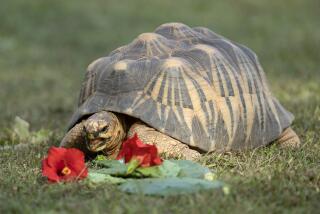MWD to Study Move of Imperiled Rodent From Path of New Projects
- Share via
RIVERSIDE — The Metropolitan Water District, worried that an endangered rodent could block a bevy of vital water supply projects in Riverside County, has launched a study the district hopes will prove the Stephens kangaroo rat can be trapped and successfully relocated.
The district’s board of directors has agreed to pay a Las Vegas consultant $500,000 to capture between 100 and 500 of the tiny, elusive rodents, move them to MWD property elsewhere in Riverside County and then monitor their behavior for a year.
Should the experiment succeed, MWD officials predict, they will be allowed to build pipelines, treatment plants and reservoirs on land occupied by the imperiled rat if they first agree to move the animals to a new home.
“A lot of time and money is being expended to protect the Stephens kangaroo rat and the relatively flat grassland habitat it needs to survive,” said Duane Georgeson, the MWD’s assistant general manager. “Our program . . . represents a new and innovative twist.”
The nocturnal, burrow-dwelling rodent, which resembles a squirrel and hops on its hind legs, was listed as an endangered species by the federal government in 1988. The animal once occupied 300,000 acres in Riverside, San Bernardino and northern San Diego counties, but habitat losses to agriculture and urban development have sent rat populations plummeting. Today, the species is scattered over only 22,000 acres in western Riverside County.
The endangered-species designation created an uproar among the county’s developers, who covet the same flat, barren land favored by the kangaroo rat. Suddenly, the builders’ property was designated “critical habitat”--off limits to bulldozers.
But last month, the U.S. Fish and Wildlife Service agreed to allow development of 4,400 acres of rat habitat if the builders bought an equal amount of land for use as protected preserves for the animal. The MWD’s consultant will capture rats for his study within that 4,400 acres.
“We are salvaging animals that are doomed and would otherwise be killed,” said Robbie Soltz, environmental affairs manager for the MWD. “It’s a win-win deal for everybody.”
To capture the animals, the MWD’s consultant will set traps baited with balls of seed and peanut butter near the rodents’ burrows. Soltz said the research subjects will be held temporarily at a zoo or university, and then released back into the wild on MWD property, perhaps near Lake Mathews.
Although Soltz said the experiment has a “high probability of success,” a spokesman for the Fish and Wildlife Service called the relocation effort “an untried method that may very well fail.”
“You can’t just vacuum up an endangered species and then plop it down in some other location,” said David Klinger, a spokesman for the service’s regional headquarters in Portland, Ore. “The habitat has to be suitable, and the animal has to be adaptable. Those are open questions at this point.”
More to Read
Sign up for Essential California
The most important California stories and recommendations in your inbox every morning.
You may occasionally receive promotional content from the Los Angeles Times.










